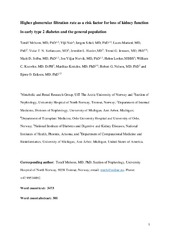Correlation between baseline GFR and subsequent change in GFR in Norwegian adults without diabetes and in Pima Indians
Permanent link
https://hdl.handle.net/10037/17340Date
2019-01-28Type
Journal articleTidsskriftartikkel
Peer reviewed
Author
Melsom, Toralf; Nair, Viji; Schei, Jørgen; Mariani, Laura; Stefansson, Vidar Tor Nyborg; Harder, Jennifer L.; Jenssen, Trond Geir; Solbu, Marit Dahl; Norvik, Jon Viljar; Looker, Helen; Knowler, William C.; Kretzler, Matthias; Nelson, Robert G.; Eriksen, Bjørn OdvarAbstract
Rationale & Objective - An elevated glomerular filtration rate (GFR), or renal hyperfiltration, may predispose individuals to subsequent rapid GFR decline in diabetes, obesity, and metabolic syndrome. Although this hypothesis is supported by results of experimental studies, the importance of hyperfiltration at the population level remains controversial. We investigated whether higher baseline GFR predicts a steeper decline in GFR.
Study Design - Longitudinal cohort studies.
Setting & Participants - 1,594 middle-aged Norwegians without diabetes (the Renal Iohexol Clearance Survey [RENIS]) and 319 Pima Indians (83% with type 2 diabetes).
Predictor - Baseline measured GFR using exogenous clearance methods.
Outcomes - Change in measured GFR over time.
Analytical Approach - Linear mixed regression models fit to assess the correlation between the random intercept (reflecting baseline GFR) and random slope (change in GFR over time).
Results - Mean baseline GFRs were 104.0 ± 20.1 (SD) and 149.4 ± 43.3 mL/min, and median follow-up durations were 5.6 (IQR, 5.2-6.0) and 9.1 (IQR, 4.0-15.0) years in the RENIS and Pima cohorts, respectively. Correlation between baseline GFR (random intercept) and slope of GFR decline was −0.31 (95% CI, −0.40 to −0.23) in the RENIS cohort and −0.41 (95% CI, −0.55 to −0.26) in the Pima cohort, adjusted for age, sex, height, and weight, suggesting that higher baseline GFRs were associated with steeper GFR decline rates.
Limitations - Different methods for measuring GFR in the 2 cohorts. Renal hyperfiltration may not reflect higher single-nephron GFR. GFR decline is assumed to be linear, which may not match the actual pattern; observed correlations may arise from natural variation.
Conclusions - Higher baseline GFR is associated with faster decline in GFR over time. If this relationship were causal, elevated GFR would represent a potentially modifiable risk factor for medium- to long-term GFR decline.


 English
English norsk
norsk